THE HISTORY OF DEVELOPMENT EUROPEAN MONEY Prepared by:

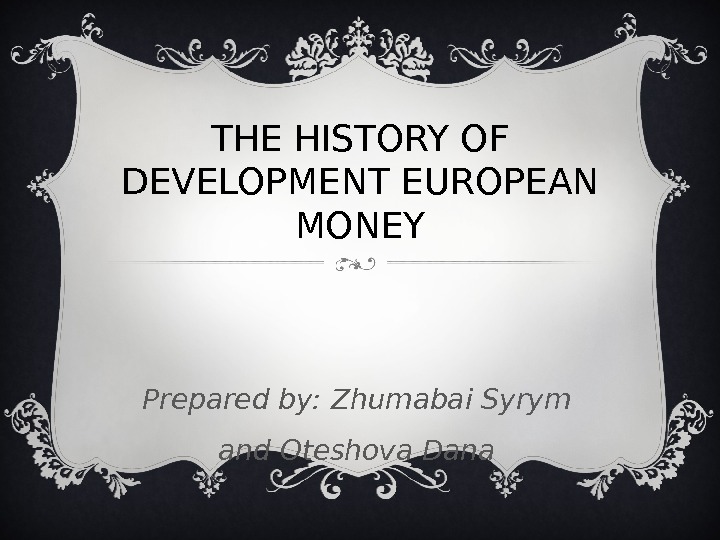



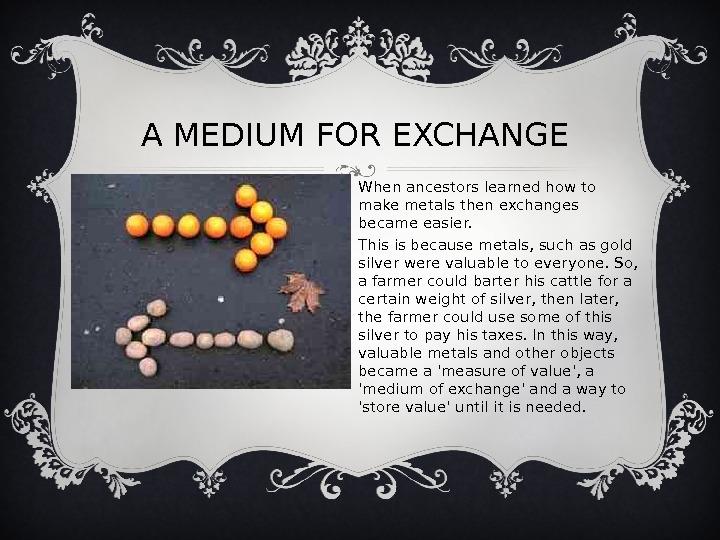

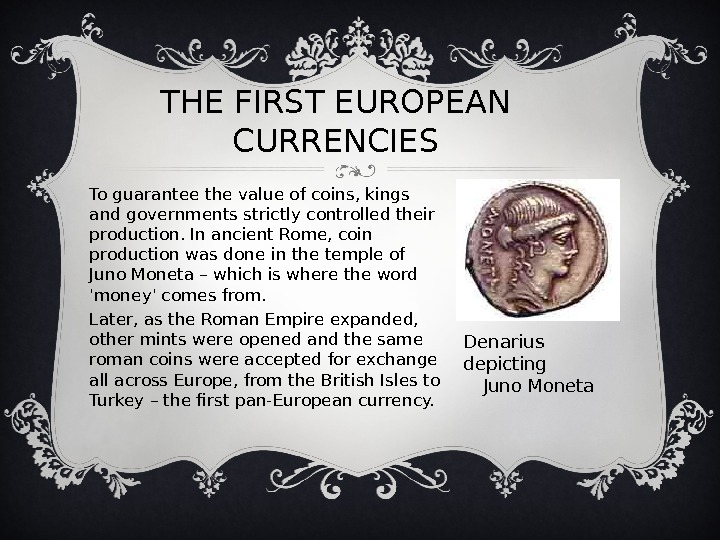
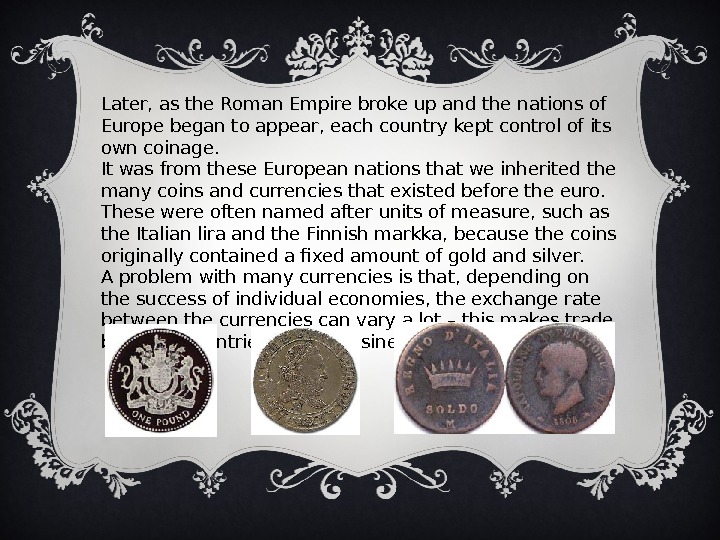
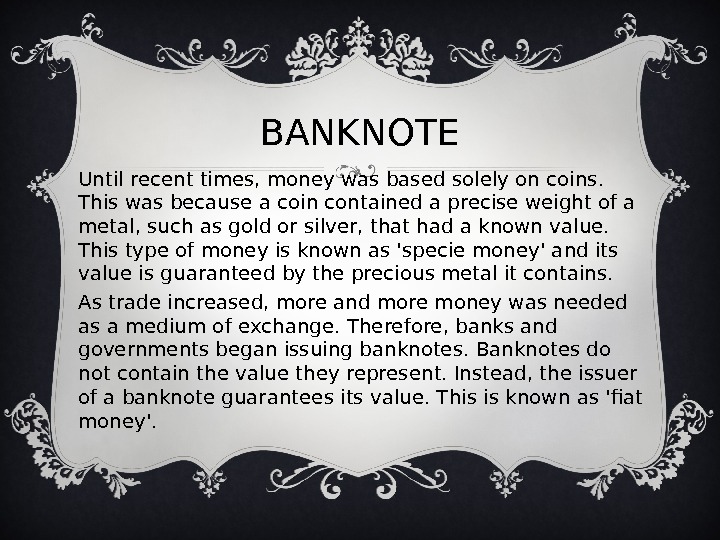
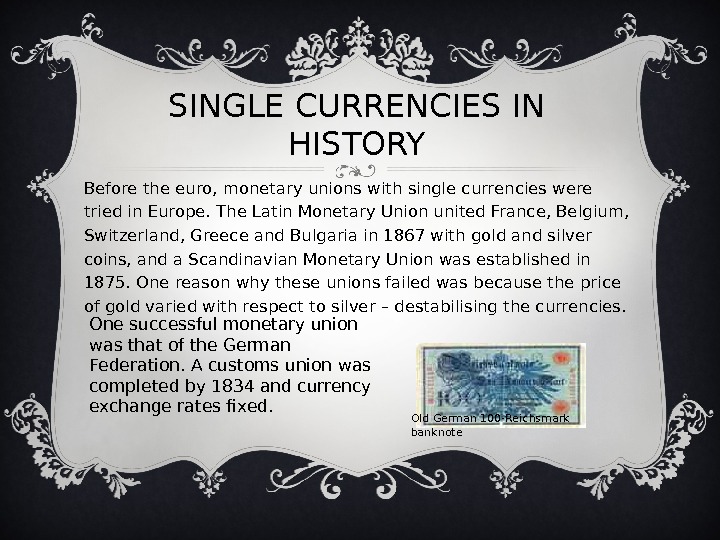
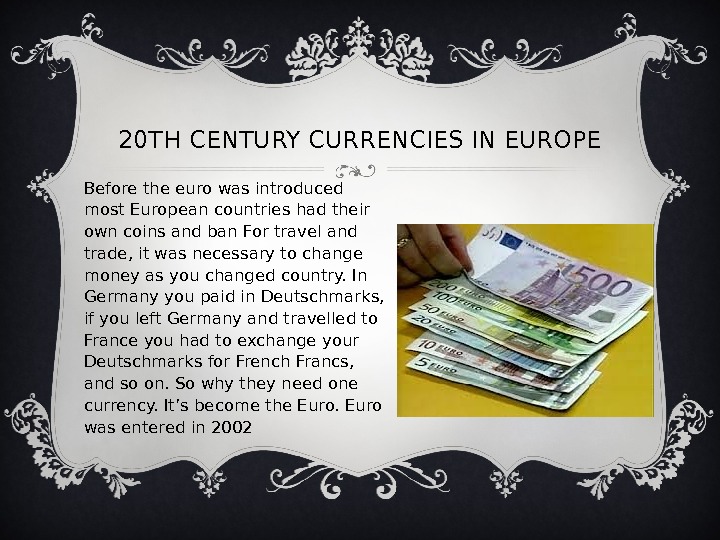

the_history_of_development_european_money.ppt
- Размер: 4.8 Mегабайта
- Количество слайдов: 12
Описание презентации THE HISTORY OF DEVELOPMENT EUROPEAN MONEY Prepared by: по слайдам
 THE HISTORY OF DEVELOPMENT EUROPEAN MONEY Prepared by: Zhumabai Syrym and Oteshova Dana
THE HISTORY OF DEVELOPMENT EUROPEAN MONEY Prepared by: Zhumabai Syrym and Oteshova Dana
 PLAN: Barter A medium for exchange The first coins The first European currencies Bankn ote Single currencies in history
PLAN: Barter A medium for exchange The first coins The first European currencies Bankn ote Single currencies in history
 BARTER Many thousands of years ago, European ancestors lived as hunters and farmers. Metals had not been discovered, so they hunted and farmed with stone tools – this time was known as the Stone Age men and women did not have the banknotes and coins that we use today. Instead, they would exchange goods with each other: for example, a hunter could exchange animal skins with a farmer for grain, or a fisherman could exchange decorative seashells for a polished stone axe with a hunter.
BARTER Many thousands of years ago, European ancestors lived as hunters and farmers. Metals had not been discovered, so they hunted and farmed with stone tools – this time was known as the Stone Age men and women did not have the banknotes and coins that we use today. Instead, they would exchange goods with each other: for example, a hunter could exchange animal skins with a farmer for grain, or a fisherman could exchange decorative seashells for a polished stone axe with a hunter.
 BARTER This exchange is known as barter. An important feature of barter is that it involves the exchange of goods that have value.
BARTER This exchange is known as barter. An important feature of barter is that it involves the exchange of goods that have value.
 A MEDIUM FOR EXCHANGE When ancestors learned how to make metals then exchanges became easier. This is because metals, such as gold silver were valuable to everyone. So, a farmer could barter his cattle for a certain weight of silver, then later, the farmer could use some of this silver to pay his taxes. In this way, valuable metals and other objects became a ‘measure of value’, a ‘medium of exchange’ and a way to ‘store value’ until it is needed.
A MEDIUM FOR EXCHANGE When ancestors learned how to make metals then exchanges became easier. This is because metals, such as gold silver were valuable to everyone. So, a farmer could barter his cattle for a certain weight of silver, then later, the farmer could use some of this silver to pay his taxes. In this way, valuable metals and other objects became a ‘measure of value’, a ‘medium of exchange’ and a way to ‘store value’ until it is needed.
 THE FIRST COINS Around 2600 years ago, the first coins were made in Asia Minor. The ancient Greeks quickly adopted this new idea and started producing silver and bronze coins, for example the silver drachma. These early coins contained a specified weight of metal with a certain value. And to guarantee this weight, the coins were stamped with a seal by the king or city or country that issued them.
THE FIRST COINS Around 2600 years ago, the first coins were made in Asia Minor. The ancient Greeks quickly adopted this new idea and started producing silver and bronze coins, for example the silver drachma. These early coins contained a specified weight of metal with a certain value. And to guarantee this weight, the coins were stamped with a seal by the king or city or country that issued them.
 THE FIRST EUROPEAN CURRENCIES To guarantee the value of coins, kings and governments strictly controlled their production. In ancient Rome, coin production was done in the temple of Juno Moneta – which is where the word ‘money’ comes from. Later, as the Roman Empire expanded, other mints were opened and the same roman coins were accepted for exchange all across Europe, from the British Isles to Turkey – the first pan-European currency. Denarius depicting Juno Moneta
THE FIRST EUROPEAN CURRENCIES To guarantee the value of coins, kings and governments strictly controlled their production. In ancient Rome, coin production was done in the temple of Juno Moneta – which is where the word ‘money’ comes from. Later, as the Roman Empire expanded, other mints were opened and the same roman coins were accepted for exchange all across Europe, from the British Isles to Turkey – the first pan-European currency. Denarius depicting Juno Moneta
 Later, as the Roman Empire broke up and the nations of Europe began to appear, each country kept control of its own coinage. It was from these European nations that we inherited the many coins and currencies that existed before the euro. These were often named after units of measure, such as the Italian lira and the Finnish markka, because the coins originally contained a fixed amount of gold and silver. A problem with many currencies is that, depending on the success of individual economies, the exchange rate between the currencies can vary a lot – this makes trade between countries a risky business, so it is discouraged.
Later, as the Roman Empire broke up and the nations of Europe began to appear, each country kept control of its own coinage. It was from these European nations that we inherited the many coins and currencies that existed before the euro. These were often named after units of measure, such as the Italian lira and the Finnish markka, because the coins originally contained a fixed amount of gold and silver. A problem with many currencies is that, depending on the success of individual economies, the exchange rate between the currencies can vary a lot – this makes trade between countries a risky business, so it is discouraged.
 BANKNOTE Until recent times, money was based solely on coins. This was because a coin contained a precise weight of a metal, such as gold or silver, that had a known value. This type of money is known as ‘specie money’ and its value is guaranteed by the precious metal it contains. As trade increased, more and more money was needed as a medium of exchange. Therefore, banks and governments began issuing banknotes. Banknotes do not contain the value they represent. Instead, the issuer of a banknote guarantees its value. This is known as ‘fiat money’.
BANKNOTE Until recent times, money was based solely on coins. This was because a coin contained a precise weight of a metal, such as gold or silver, that had a known value. This type of money is known as ‘specie money’ and its value is guaranteed by the precious metal it contains. As trade increased, more and more money was needed as a medium of exchange. Therefore, banks and governments began issuing banknotes. Banknotes do not contain the value they represent. Instead, the issuer of a banknote guarantees its value. This is known as ‘fiat money’.
 SINGLE CURRENCIES IN HISTORY Before the euro, monetary unions with single currencies were tried in Europe. The Latin Monetary Union united France, Belgium, Switzerland, Greece and Bulgaria in 1867 with gold and silver coins, and a Scandinavian Monetary Union was established in 1875. One reason why these unions failed was because the price of gold varied with respect to silver – destabilising the currencies. One successful monetary union was that of the German Federation. A customs union was completed by 1834 and currency exchange rates fixed. Old German 100 -Reichsmark banknote
SINGLE CURRENCIES IN HISTORY Before the euro, monetary unions with single currencies were tried in Europe. The Latin Monetary Union united France, Belgium, Switzerland, Greece and Bulgaria in 1867 with gold and silver coins, and a Scandinavian Monetary Union was established in 1875. One reason why these unions failed was because the price of gold varied with respect to silver – destabilising the currencies. One successful monetary union was that of the German Federation. A customs union was completed by 1834 and currency exchange rates fixed. Old German 100 -Reichsmark banknote
 20 TH CENTURY CURRENCIES IN EUROPE Before the euro was introduced most European countries had their own coins and ban For travel and trade, it was necessary to change money as you changed country. In Germany you paid in Deutschmarks, if you left Germany and travelled to France you had to exchange your Deutschmarks for French Francs, and so on. So why they need one currency. It’s become the Euro was entered in
20 TH CENTURY CURRENCIES IN EUROPE Before the euro was introduced most European countries had their own coins and ban For travel and trade, it was necessary to change money as you changed country. In Germany you paid in Deutschmarks, if you left Germany and travelled to France you had to exchange your Deutschmarks for French Francs, and so on. So why they need one currency. It’s become the Euro was entered in


